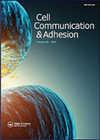N-cadherin/catenin complex as a master regulator of intercalated disc function.
Q2 Biochemistry, Genetics and Molecular Biology
Cell Communication and Adhesion
Pub Date : 2014-06-01
Epub Date: 2014-04-28
DOI:10.3109/15419061.2014.908853
引用次数: 55
Abstract
Abstract Intercellular adhesive junctions are essential for maintaining the physical integrity of tissues; this is particularly true for the heart that is under constant mechanical load. The correct functionality of the heart is dependent on the electrical and mechanical coordination of its constituent cardiomyocytes. The intercalated disc (ID) structure located at the termini of the rod-shaped adult cardiomyocyte contains various junctional proteins responsible for the integration of structural information and cell–cell communication. According to the classical description, the ID consists of three distinct junctional complexes: adherens junction (AJ), desmosome (Des), and gap junction (GJ) that work together to mediate mechanical and electrical coupling of cardiomyocytes. However, recent morphological and molecular studies indicate that AJ and Des components are capable of mixing together resulting in a “hybrid adhering junction” or “area composita.” This review summarizes recent progress in understanding the in vivo function(s) of AJ components in cardiac homeostasis and disease.


n -钙粘蛋白/连环蛋白复合物作为嵌入盘功能的主要调节因子。
细胞间黏附连接对于维持组织的物理完整性至关重要;对于承受恒定机械负荷的心脏来说尤其如此。心脏的正常功能依赖于其组成心肌细胞的电和机械协调。位于棒状成年心肌细胞末端的嵌入盘(ID)结构包含各种负责结构信息整合和细胞间通讯的连接蛋白。根据经典描述,ID由三种不同的连接复合物组成:粘附连接(AJ)、桥粒(Des)和间隙连接(GJ),它们共同介导心肌细胞的机械和电偶联。然而,最近的形态学和分子研究表明,AJ和Des成分能够混合在一起,形成“杂交粘接结”或“复合区”。本文综述了AJ成分在心脏稳态和疾病中的体内功能的最新进展。
本文章由计算机程序翻译,如有差异,请以英文原文为准。
求助全文
约1分钟内获得全文
求助全文
来源期刊

Cell Communication and Adhesion
生物-生化与分子生物学
CiteScore
2.50
自引率
0.00%
发文量
0
审稿时长
>12 weeks
期刊介绍:
Cessation
Cell Communication and Adhesion is an international Open Access journal which provides a central forum for research on mechanisms underlying cellular signalling and adhesion. The journal provides a single source of information concerning all forms of cellular communication, cell junctions, adhesion molecules and families of receptors from diverse biological systems.
The journal welcomes submission of original research articles, reviews, short communications and conference reports.
 求助内容:
求助内容: 应助结果提醒方式:
应助结果提醒方式:


